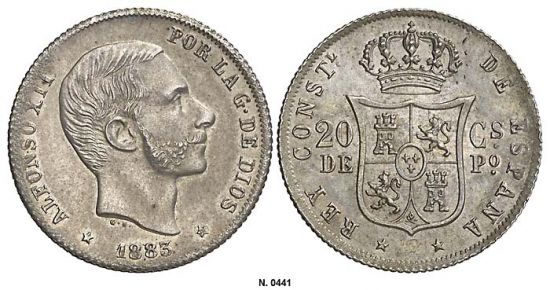Philippines 1883 20 centimos
The first specimen shown was lot 441 in Aureo y Calicó sale 232 (Barcelona, March 2011), where it sold for 1,000 euros (about US$1,650 including buyer's fee). The catalog description[1] noted,
"1883. Manila. 20 centavos. Bella. Gran parte de brillo original. Rara así. S/C-. (Twenty centavos of 1883, Manila mint, nice, most of the luster remaining, rare thus, about Uncirculated.)"
The second specimen shown was lot 434 in Aureo y Calicó sale 242 (Barcelona, March 2011), where it sold for 320 euros (about US$487 including buyer's fee). The catalog description[3] noted,
"Alfonso XII (1874-1885). 1883. Manila. 20 centavos. Bella. Muy rara así. EBC/EBC+. (Twenty centavos of 1883, Manila mint, nice, rare thus, extremely fine.)"
This coin is one of a series minted by the Spanish authorities in Manila in an attempt to drive out foreign coin (mostly Mexican) circulating there. There are also silver ten and fifty centimos and gold one, two and four pesos, all with the portrait of Queen Isabella. During the reign of Alfonso XII, silver ten, twenty and fifty centimos were struck dated 1880-85. The SCWC lists this date as common with 1883/2 and 1888, 8 over horizontal 8, varieties.
The Philippines were conquered by Spain in the late 1500's. Other than introducing Christianity, the colonizers made little effort to develop the islands which gradually fell into the hands of the friars. Manila was important only as a way station on the route from China to Mexico and whatever coins were used there were derived therefrom. Crude, locally produced copper coins were issued c.1798-1835 and in the 1830's large quantities of Latin American pesos were counterstamped "F.7" or "Y.II" for local circulation. Finally, about 1860, a reforming government in Madrid sent the resources to reorganize the Manila mint and modern coinage began. These included gold one, two and four pesos (struck 1861-68). After the Americans seized the archipelago during the Spanish-American war, all the Spanish issues were demonetized in 1904[2].
Recorded mintage: 1,972,000.
Specification: 5.19 g, 0.835 fine silver, .139 troy oz ASW.
Catalog reference: Cayón-17554, Cal. 90, KM 149.
- Cayón, Adolfo, Clemente Cayón and Juan Cayón, Las Monedas Españolas, del Tremis al Euro: del 411 a Nuestros Dias, 2 volumes, Madrid: Cayón-Jano S.L., 2005.
- Calicó, Xavier, Numismática Española: Catálogo General con Precios de Todas las Monedas Españolas Acuñadas desde Los Reyes Católicos Hasta Juan Carlos I, 1474 a 2001, Barcelona: Aureo & Calicó, 2008.
- [1]Sisó, Teresa, Eduardo Domingo and Lluís Lalana, Selección de 500 Monedas, Medallas y Billetes, Barcelona: Aureo y Calicó Subastas, 2011.
- Basso, Aldo P., Coins, Medals and Tokens of the Philippines, Menlo Park, CA: 1968.
- Ganzon de Legarda, Angelita, Piloncitos to Pesos, A Brief History of Coinage in the Philippines, Manila: Bancom Development Corporation, 1976.
- Michael, Thomas, and Tracy L. Schmidt, Standard Catalog of World Coins, 1801-1900, 9th ed., Iola, WI: Krause Publications, 2019.
- [2]Ganzon de Legarda, Angelita, Piloncitos to Pesos, A Brief History of Coinage in the Philippines, Manila: Bancom Development Corporation, 1976.
- [3]Sisó, Teresa, Eduardo Domingo and Lluís Lalana, Selección de 500 Monedas, Medallas y Billetes, Barcelona: Aureo y Calicó Subastas, 2012.
Link to:
- 1882 20 centimos
- 1883 10 centimos
- 1882 4 pesos
- 1884 20 centimos
- return to coins of the Philippines
- Coins and currency dated 1883

